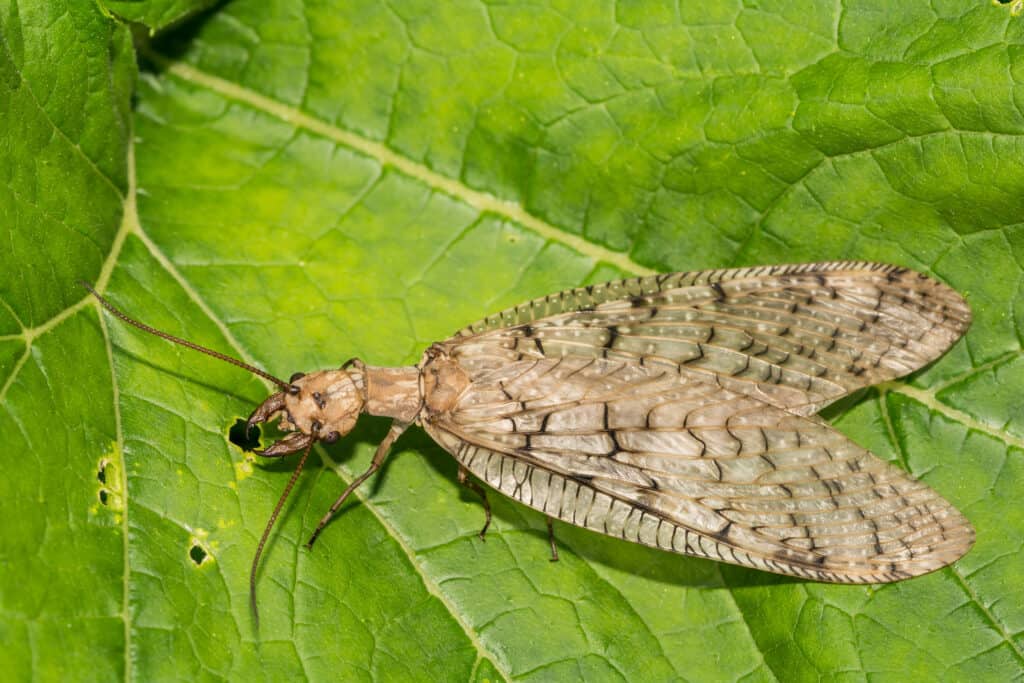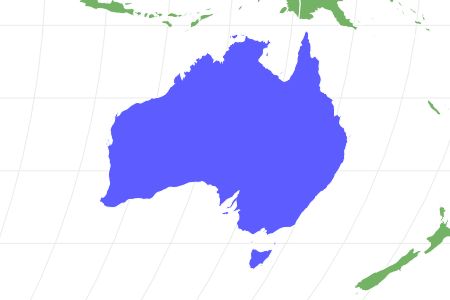Dobsonfly
The dobsonfly spends up three years as a larva, and only a week as an adult.
Advertisement
Dobsonfly Scientific Classification
Read our Complete Guide to Classification of Animals.
Dobsonfly Conservation Status
Dobsonfly Facts
- Prey
- Aquatic insects and small invertebrates.
- Name Of Young
- Larvae
- Group Behavior
- Solitary
- Fun Fact
- The dobsonfly spends up three years as a larva, and only a week as an adult.
- Most Distinctive Feature
- Veined wings and sclerotized mandibles.
- Wingspan
- 3.9 to 5.5 inches
- Diet
- Omnivore
Dobsonfly Physical Characteristics
- Color
- Brown
- Grey
- Yellow
- Lifespan
- 3-10 days
- Length
- 2-5 inches
- Venomous
- No
- Aggression
- Low
View all of the Dobsonfly images!
Dobsonflies are a group of insects that belong to the family Corydalidae. Insects in this subfamily are large and fearsome-looking. They’re among the largest aquatic insects in North America. Anglers popularly use the larvae of dobsonflies (hellgrammites) as fish bait. The larvae live in streams. Adults often sit near water bodies.
Dobsonflies Species, Types, and Scientific name
Dobsonflies are a subfamily of insects that belong to the family Corydalidae and order Megaloptera — an order of insects that contain more than 300 known species, including alderflies and fishflies. There are 9 genera of dobsonflies with 60 species of the insects. The origin and meaning of the name “dobsonfly” are unknown.
One of the best-described members of this group of insects is the Corydalus which includes the eastern dobsonfly (Corydalus cornutus). This large insect with a body length of about two inches likes to stay near water bodies.
The nine genera of dobsonflies are typically grouped into four lineages. These include:
- The Protohermes lineage: this contains the two genera (Neurhermes and Protohermes). They live in Northwest India, Indonesia, China, Japan, and other parts of Asia.
- The Chloroniella lineage: this contains only one genus Chloroniella that is exclusive to South Africa.
- The Nevromus lineage: this contains three genera (Acanthacorydalis, Nevromus, and Neoneuromus) found in Northwest India to Southeast Asia.
- The Corydalus lineage contains three genera: Platyneuromus, Chloronia, and Corydalus. They’re typically found in the Americas.
Appearance: How To Identify Dobsonflies

An eastern dobsonfly, which makes North America its home.
©Jay Ondreicka/Shutterstock.com
Next to butterflies, adult dobsonflies are among the largest insects in the temperate zones of North America. Most species have an average wingspan of about seven inches and measure between two to four inches in length from the top of the head to the tip of their wings. However, some species, such as the Asian Acanthacorydalis fruhstorferi, can get even bigger with a wingspan of up to eight and a half inches. Based on this size, dobsonflies are the largest aquatic insects in the world.
The color of their wings is typically grayish or brownish-gray. The wings are heavily veined and are often spotted. They have long and thread-like antennae and usually hold their wings in a roof-like manner over their body. Despite the size of their wings, adult dobsonflies are not great fliers.
Underneath the wings, they have a soft cylindrical body that is typically about three inches in length. The color of their body varies from yellow to brownish. The males of some species have long and curved mandibles, which they use for defense and as a sort of reproductive display in some species. Due to the size of their mandibles, the males cannot use them to bite. Females, on the other hand, have short and heavily sclerotized mandibles that can deliver powerful bites when threatened.
Habitat: Where to find Dobsonflies
The 60 species of dobsonflies are distributed across various locations in North America, South America, Asia, and South Africa. Hellgrammites, the larvae of this insect, are prominent aquatic dwellers that live in flowing fresh water such as streams. They live in well-oxygenated water and are often eaten by fish such as bass. Mature larvae often migrate to decaying vegetation, wet soil, or moss not far from the water, where they develop into pupae from where adults emerge. The adults don’t travel too far from the water mainly because they’re not excellent fliers. They’re mostly active at night and may be attracted to light.
Diet: What do Dobsonflies eat?
Adult dobsonflies have a short lifespan, and they do not feed. The larvae of dobsonflies are ferocious predators that feed on various aquatic insects and small invertebrates in the water. Their diet may consist of larvae of stoneflies, caddisflies, mayflies, and chironomid midges.
What eats Dobsonflies?”
Fishes, especially bass, feed on hellgrammites. Because of this and due to their size and ferocious temperament, anglers often prefer them as bait for catching bass and other fishes. They’re able to endure for long on a hook and are effective for attracting fish.
Prevention: How to get rid of Dobsonflies
Dobsonflies are aquatic insects that typically live around streams, rivers, and lakes. However, adults may be a nuisance in homes due to their attraction to light sources. They hardly constitute a problem, and they’re not harmful. However, they can be a little annoying.
You can get rid of dobsonflies by applying chemical insecticides around the perimeter of your home. This gets rid of the insects around your home and prevents them from coming back. To prevent future infestations, you should consider changing your outdoor lighting to special yellow bug light bulbs as well.
Related Animals…
View all 110 animals that start with DDobsonfly FAQs (Frequently Asked Questions)
Are dobsonflies dangerous?
Dobsonflies are not particularly dangerous. Handling them is not recommended, though. Females have strong serrated mandibles that can inflict a painful bite if they’re handled carelessly. However, they’re not venomous.
How do you identify dobsonflies?
Dobsonflies are characterized by a long cylindrical body with large, gray to brownish-colored wings. Males of some species possess large mandibles, making them a fearsome appearance. The females, on the other hand, have short, inconspicuous jaws.
How long do dobsonflies live?
Dobsonflies spend most of their life in the larva form. They may spend between 1-5 years in the larva stage. Once they hatch into adults, they only live for about a week, during which they reproduce and diet.
Are dobsonflies rare?
The dobsonfly is a rare aquatic insect. Their habitat is restricted to some parts of North and South America, South Africa, and Asia. Also, in places where they’re found, they don’t venture far away from the water bodies and only live for a few days. Dobsonflies are also nocturnal and are active around late spring to mid-summer. Given all of these conditions, encounters with them are not quite common.
Thank you for reading! Have some feedback for us? Contact the AZ Animals editorial team.
Sources
- Iowa State University, Available here: https://hortnews.extension.iastate.edu/dobsonfly
- Britannica, Available here: https://www.britannica.com/animal/dobsonfly
- Wikipedia, Available here: https://en.wikipedia.org/wiki/Dobsonfly
- University of Maine, Available here: https://extension.umaine.edu/home-and-garden-ipm/fact-sheets/common-name-listing/dobsonflies/
- Solutions Pest and Lawn, Available here: https://www.solutionsstores.com/dobsonfly-control

















